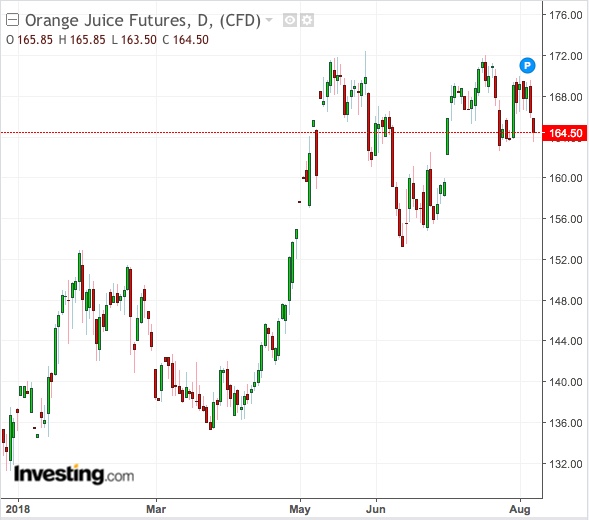In the 1983 Hollywood classic “Trading Places”, Ralph Bellamy’s trader character, Randolph Duke, famously says: “And then there are other commodities, like frozen orange juice... and gold. Though, of course, gold doesn't grow on trees like oranges.” Three and a half decades on, some traders think oranges will be this year’s gold on trees, delivering the bullish returns the precious metal has not, even as technical charts tell a different story.
US frozen concentrated orange juice (FCOJ) boasts the fourth best returns for 2018 among 60 commodity and global macro futures tracked by Barchart. New York-traded FCOJ is up nearly 18 percent on the year after a string of rallies in the first half, supported by forecasts that top orange-growing state Florida could have the lowest output in 75 years. Since August began, that bullish trend has, however, wavered on signs of improving growing conditions in the so-called Sunshine State.

Investing.com’s daily tehnicals call for a “Sell” in FCOJ after the market slipped below the 50-day moving average of $1.6391 per lb in electronic trade ahead of Wednesday’s session. Fibonacci patterns, meanwhile, indicate strong support at $1.6353 for FCOJ’s spot September contract. That suggested a further drop of nearly three cents from Tuesday’s settlement of $1.6640, before strong recovery begins.
But some are challenging that technical outlook.
Rally To $2 By Year-End?
“We still have a very positive view on OJ,” said James Cordier, founder of Tampa, Florida-based broker Optionsellers.com, and a veteran follower of the US juice market. “We think it’ll resume its trek higher and finish the year at between $1.90 and $2 a lb.”
Cordier said his prognosis was based on crop conditions in Brazil, the world’s largest citrus producer that, in his opinion, is a better indicator of supply-demand for US juice than Florida.
“The growing conditions in Brazil are not really that good now for citrus,” he said. “The Brazilian production is going to be smaller than anticipated. As for Florida, we think the supply coming out of there is going to be extremely small.”
While some speculators were trying to pressure the market with short-selling, “the long term fundamentals continue to be bullish from a supply side,” Cordier said. “That will continue to underpin orange juice futures even when they’re down from time to time for reasons that aren’t too clear.”
Shifting Crop Conditions
The US Department of Agriculture, citing figures from the Agricultural Trade Office of Sao Paulo, said in June the Brazilian orange crop for 2018/19 was projected at 393 million boxes, down 27 percent from the previous season. Citrus trees were stressed from last year’s production and high temperatures in October 2017, which had negatively affected fruit setting, the USDA said.
The decrease in oranges available for crushing from both the Brazilian and US crops will likely result in a sharply reduced FCOJ production of 1.032 million metric tonnes this year versus last season’s 1.447 million metric tonnes, the USDA added in that June report.
But in an update on Monday, the US crop authority said weather conditions had turned favorable across Florida’s citrus patch of late, with typical warm temperatures, and “reports on the progress of the fruit crop were positive in all areas”.
Hackett Financial Advisors, an agricultural markets consultancy in Boca Raton, Florida, said earlier this week the ongoing Brazilian drought will influence crop outcomes from fall onwards, and “greatly impact next year’s Brazil OJ output”.
Neutral To Cautious Stance On Prices
“Smart money selling continues as we move closer to a sell signal but as of yet we remain in neutral territory,” it said.
Others said FCOJ charts clearly showed the market had become riskier for bulls.
“I will be recommending a bearish position if prices break the 5-week low standing at $162.55 on a closing basis, while then placing the stop loss above the 10-day high at $1.70 as the risk will be around $1,200 per contract plus slippage & commission,” Mike Seery of Seery Futures in Plainfield, Illinois, wrote in a Tuesday commentary.
Seery acknowledged that juice had delivered some of the best returns in commodities this year but said the consolidation since the second-quarter meant prices had possibly topped out. Still, investors who tread with caution could have “risk/reward in their favor as orange juice can have tremendous volatility, with large price swings on a daily basis,” he added.
